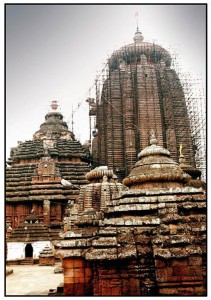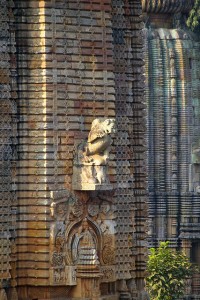Lingaraj – one of the largest and oldest temples of Bhubaneshwar
 King Yayati built the construction of the largest temple of Bhubaneshwar – Lingaraj Temple, located near the Bindu Sagar. Here there is a famous lingam, which many centuries ago incorporated the spirit of Shiva and took his form. Although many people believe that Yayati was a mythical creature, the inscriptions in the temple of Jagannath at Puri indicate that he really existed and that after his orders this temple was constructed and dedicated to the great ruler of the three worlds – Tribhuvanesvara.
King Yayati built the construction of the largest temple of Bhubaneshwar – Lingaraj Temple, located near the Bindu Sagar. Here there is a famous lingam, which many centuries ago incorporated the spirit of Shiva and took his form. Although many people believe that Yayati was a mythical creature, the inscriptions in the temple of Jagannath at Puri indicate that he really existed and that after his orders this temple was constructed and dedicated to the great ruler of the three worlds – Tribhuvanesvara.
 Lingaraj temple has an elongated shape, it has been working up to this day, but, unfortunately, you have to be an Indian if you want to enter it. The temple is surrounded by a high wall to protect against the invaders, however, it can be seen from a special platform, built long ago nearby by the British. The temple has a wonderful, elaborate tower (vimana) the height of which is 127 feet. This is truly an architectural wonder. It consists of several vertical sections and niches are filled by smaller miniature towers (vimana-s), created with extraordinary care. Under the crown spire (amalaka) you can see some lions performed in a Gothic style, these animals are the emblem of the rulers of Kesari, the church patrons. The top the tower is empty, it is composed of several sections, which you can get by the stairs made in a seven-inch thick wall. Its height is in sharp contrast with the temple (mandir), which is situated just in front of it.
Lingaraj temple has an elongated shape, it has been working up to this day, but, unfortunately, you have to be an Indian if you want to enter it. The temple is surrounded by a high wall to protect against the invaders, however, it can be seen from a special platform, built long ago nearby by the British. The temple has a wonderful, elaborate tower (vimana) the height of which is 127 feet. This is truly an architectural wonder. It consists of several vertical sections and niches are filled by smaller miniature towers (vimana-s), created with extraordinary care. Under the crown spire (amalaka) you can see some lions performed in a Gothic style, these animals are the emblem of the rulers of Kesari, the church patrons. The top the tower is empty, it is composed of several sections, which you can get by the stairs made in a seven-inch thick wall. Its height is in sharp contrast with the temple (mandir), which is situated just in front of it.
Bhubaneswar is risen by the greatest construction, known as the Sri Mandir and located in the cobbled courtyard among the other 65 churches of different sizes. But it is not the only thing noticeable.
 It seems that the whole group of churches is rushing up to the main shrine, a visitor usually wanders among them, as in a forest. The accumulation of Buddhist stupas (the storages of the Buddhist relics) in Bodh Gaya, in Bihar appears in mind. Many small buildings are the miniatures of Sri Mandir supposedly built by the faithful. This ensemble of churches, like a field of sunflowers facing the sun, was built in the early 11th century. However, some of the complex parts are almost 1,400 years old, and some of them are more modern.
It seems that the whole group of churches is rushing up to the main shrine, a visitor usually wanders among them, as in a forest. The accumulation of Buddhist stupas (the storages of the Buddhist relics) in Bodh Gaya, in Bihar appears in mind. Many small buildings are the miniatures of Sri Mandir supposedly built by the faithful. This ensemble of churches, like a field of sunflowers facing the sun, was built in the early 11th century. However, some of the complex parts are almost 1,400 years old, and some of them are more modern.
 Going up the stone steps to the temple, the visitor enters into a series of outdoor pavilions, the first of them is a great bhog mandir of a square form according to its plan. It is followed by a small room – a dance hall. Both of these rooms were added to the main building about 200 years after its construction. Going from the the room where devadasi-s danced before God in the heat of religious passion, a visitor enters a gallery decorated with columns leading to the altar (deul). The interior is decorated with nothing, it reigns strict atmosphere, compared to the abundance of external decorative details. Deity is represented as a phallus carved from huge granite boulders. It is set in the yoni, made of black chlorite. Parvati temple in the southeast corner of the complex is attributed by Lingaraj Ganga dynasty and, it was probably was built in the 12th century.
Going up the stone steps to the temple, the visitor enters into a series of outdoor pavilions, the first of them is a great bhog mandir of a square form according to its plan. It is followed by a small room – a dance hall. Both of these rooms were added to the main building about 200 years after its construction. Going from the the room where devadasi-s danced before God in the heat of religious passion, a visitor enters a gallery decorated with columns leading to the altar (deul). The interior is decorated with nothing, it reigns strict atmosphere, compared to the abundance of external decorative details. Deity is represented as a phallus carved from huge granite boulders. It is set in the yoni, made of black chlorite. Parvati temple in the southeast corner of the complex is attributed by Lingaraj Ganga dynasty and, it was probably was built in the 12th century.